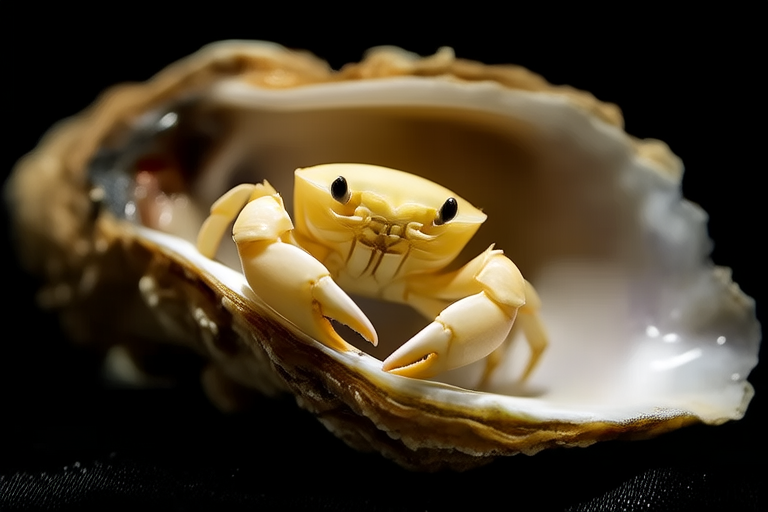The Pea Crab: A Tiny Marvel Living Inside Oysters
Welcome to the fascinating world of the pea crab (Pinnotheres pisum), a diminutive creature that has mastered the art of living within the confines of an oyster. This article delves into the life of this tiny crab, exploring its size, habitat, unique adaptations, relationship with its host, reproductive strategies, diet, and the threats it faces. We’ll also uncover some interesting myths and facts associated with this remarkable species.
Size and Habitat
The pea crab is aptly named due to its small size, typically measuring between 1 and 3 centimeters in length. These crabs are often found nestled within the gills of oysters, specifically the European flat oyster (Ostrea edulis) and the Pacific oyster (Crassostrea gigas). The oyster provides a protective shell for the pea crab, shielding it from predators and offering a stable environment in which to thrive.
Unique Adaptations
Living within the gills of an oyster requires several specialized adaptations. One of the most notable is the pea crab’s flattened body, which allows it to fit snugly within the oyster’s gill chambers. Additionally, these crabs possess thin, delicate limbs that enable them to navigate the narrow spaces between the oyster’s gills without causing damage. Their transparent exoskeleton further aids in camouflage, making it difficult for potential predators to spot them.
Relationship with Its Host
The relationship between the pea crab and its oyster host is complex and multifaceted. While the pea crab benefits from the protection and resources provided by the oyster, the relationship is not entirely one-sided. In return, the pea crab can help its host by feeding on parasites and detritus within the gills, potentially improving the oyster’s health. However, the presence of pea crabs can also negatively impact the oyster’s growth and reproductive success.
Reproduction Process
The pea crab’s reproductive cycle is closely tied to its host. Mating typically occurs when both male and female pea crabs are present within the same oyster. After mating, the female carries her fertilized eggs beneath her abdomen until they hatch. The larvae then disperse into the water column, where they must find a suitable oyster to enter and continue their lifecycle.
Diet
Pea crabs have a varied diet, primarily consisting of detritus, plankton, and the occasional small organism. They scavenge within the gills of their host, consuming organic material and other microorganisms that settle there. This diet helps maintain the cleanliness of the oyster’s gills, contributing to the overall health of both the crab and its host.
Threats to Existence
Like many species, the pea crab faces several threats to its existence. Habitat destruction, overfishing, and pollution pose significant challenges. Additionally, climate change may alter the distribution and abundance of both the pea crab and its host, potentially leading to declines in population numbers. Conservation efforts aimed at protecting oyster reefs and reducing environmental stressors are crucial for ensuring the survival of this unique species.
Interesting Facts and Myths
Throughout history, the pea crab has been the subject of various myths and legends. In some cultures, finding a pea crab within an oyster was considered a sign of good luck, while others believed it indicated that the oyster was particularly flavorful. Scientifically, the pea crab’s ability to live symbiotically within an oyster continues to intrigue researchers, offering valuable insights into the evolution of mutualistic relationships.
One fascinating aspect of the pea crab is its role in the culinary world. In some regions, the presence of a pea crab within an oyster is seen as a delicacy, adding an extra layer of flavor and texture to the dish. However, it’s important to note that consuming oysters containing pea crabs does not pose any significant health risks.
Another interesting fact about the pea crab is its resilience. Despite its small size and seemingly fragile nature, these crabs have managed to survive and thrive in environments that would be inhospitable to larger organisms. Their ability to adapt to changing conditions and their close association with their hosts highlight the importance of biodiversity and the intricate web of life.
Conclusion
The pea crab (Pinnotheres pisum) is a remarkable species that has adapted to life within the gills of oysters. Its small size, unique adaptations, and complex relationship with its host make it a fascinating subject of study. By understanding the challenges faced by this tiny crab and the threats to its existence, we can work towards preserving its place in the ecosystem. Whether you’re a biologist, chef, or simply someone who appreciates the wonders of nature, the pea crab offers a captivating glimpse into the diverse and interconnected world of marine life.
